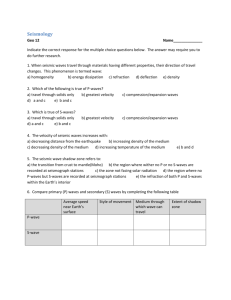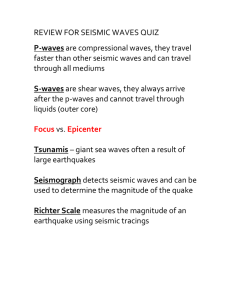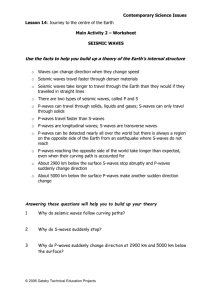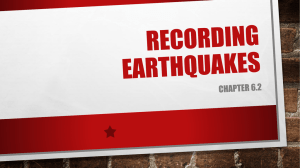Ch. 6.2 Notes
advertisement
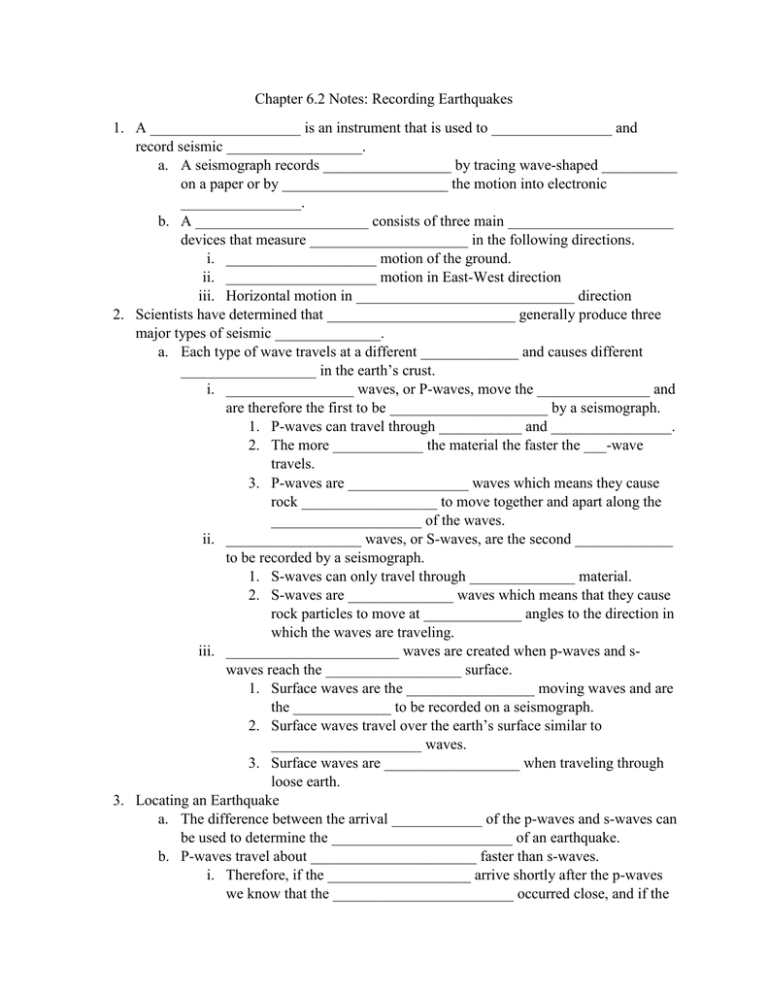
Chapter 6.2 Notes: Recording Earthquakes 1. A ____________________ is an instrument that is used to ________________ and record seismic __________________. a. A seismograph records _________________ by tracing wave-shaped __________ on a paper or by ______________________ the motion into electronic ________________. b. A _______________________ consists of three main ______________________ devices that measure _____________________ in the following directions. i. ____________________ motion of the ground. ii. ____________________ motion in East-West direction iii. Horizontal motion in _____________________________ direction 2. Scientists have determined that _________________________ generally produce three major types of seismic ______________. a. Each type of wave travels at a different _____________ and causes different __________________ in the earth’s crust. i. _________________ waves, or P-waves, move the _______________ and are therefore the first to be _____________________ by a seismograph. 1. P-waves can travel through ___________ and ________________. 2. The more ____________ the material the faster the ___-wave travels. 3. P-waves are ________________ waves which means they cause rock __________________ to move together and apart along the ____________________ of the waves. ii. __________________ waves, or S-waves, are the second _____________ to be recorded by a seismograph. 1. S-waves can only travel through ______________ material. 2. S-waves are ______________ waves which means that they cause rock particles to move at _____________ angles to the direction in which the waves are traveling. iii. _______________________ waves are created when p-waves and swaves reach the __________________ surface. 1. Surface waves are the _________________ moving waves and are the _____________ to be recorded on a seismograph. 2. Surface waves travel over the earth’s surface similar to ____________________ waves. 3. Surface waves are __________________ when traveling through loose earth. 3. Locating an Earthquake a. The difference between the arrival ____________ of the p-waves and s-waves can be used to determine the ________________________ of an earthquake. b. P-waves travel about ______________________ faster than s-waves. i. Therefore, if the ___________________ arrive shortly after the p-waves we know that the ________________________ occurred close, and if the s-waves arrive a ______________ time after the p-waves we know the earthquake occurred ______________ away. c. To determine the exact ___________________ of the epicenter scientists ___________ the difference between the __________________ times of the two waves and compare them to a standard _______________ that turns the times into distances from the ________________________. i. In order to determine the _________________ you must have information from at least three seismograph ________________ at different locations. ii. __________________ are drawn on a map using the ______________________ recorded. iii. Where the circles __________________ is the epicenter of the earthquake. 4. Earthquake Measurement a. ________________________ is a measure of the __________________ released by an earthquake and is also described as the amount of ______________ motion. i. Magnitude is measured using the _______________________ scale or the ______________________ _______________________ Scale. 1. The _______________ scale is related to the _________________ of the earthquake while the moment magnitude scale is related to the ____________________ of the earthquake. ii. Earthquakes with a magnitude less than a _______ are called ________________________ and are usually not felt by people. iii. The ____________________ scale expresses the ____________________ of an earthquake, or the amount of ________________________ it causes through roman numerals and ___________________________ of damage. 1. The Mercalli scale describes an earthquake with a scale from _____________, where a rating of II is a low ________________.


